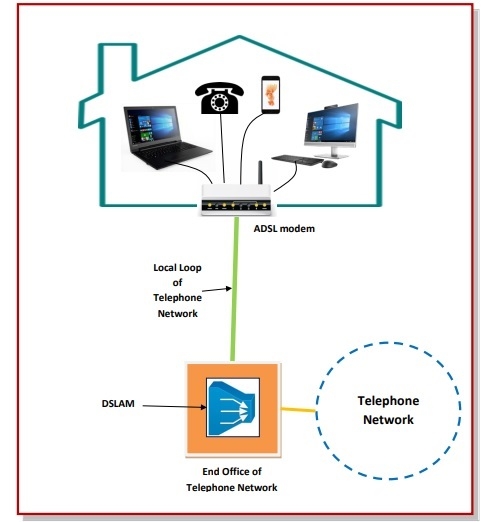
 Data Structure
Data Structure Networking
Networking RDBMS
RDBMS Operating System
Operating System Java
Java MS Excel
MS Excel iOS
iOS HTML
HTML CSS
CSS Android
Android Python
Python C Programming
C Programming C++
C++ C#
C# MongoDB
MongoDB MySQL
MySQL Javascript
Javascript PHP
PHP
- Selected Reading
- UPSC IAS Exams Notes
- Developer's Best Practices
- Questions and Answers
- Effective Resume Writing
- HR Interview Questions
- Computer Glossary
- Who is Who
Asymmetric Digital Subscriber Loop (ADSL)
Asymmetric Digital Subscriber Line (ADSL) is a type of broadband communications technology that transmits digital data at a high bandwidth over existing phone lines to homes and businesses.
In order to access ADSL, a Digital Subscriber Line modem (DSL modem) is installed at the client side. The DSL modem sends data bits over the local loop of the telephone network. The local loop is a two – wire connection between the subscriber’s house and the end office of the telephone company. The data bits are accepted at the end office by a device called Digital Subscriber Line Access Multiplexer (DSLAM).
Features of ADSL
ADSL is one among the DSL family of technologies.
ADSL is used in the local loop of the telephone network, i.e. the part of the telephone network that connects the customer premises with the end office of the telephone company.
The telephone company uses a Digital Subscriber Line Access Multiplexer (DSLAM) at its end office so that multiple ADSL users can be connected to the high-speed backbone network.
-
Most ADSL communications are full-duplex communication. It is achieved by any of the following technologies −
frequency-division duplex (FDD)
echo-cancelling duplex (ECD)
time-division duplex (TDD)
The most common technology uses FDD. Here two separate bands are used for upstream and downstream communications.
ADSL uses frequency bands 26.075 kHz to 137.825 kHz for upstream communication and 138–1104 kHz is downstream communication. Voice transmission occurs at less than 4 KHz. So, data transmission occurs simultaneously with voice transmission.
ADSL filters are used on customer premises with non-DSL connections.
ADSL uses analog sinusoidal carrier waves for data transmission. The waves are modulated and demodulated at the customer premises with ADSL modems.


